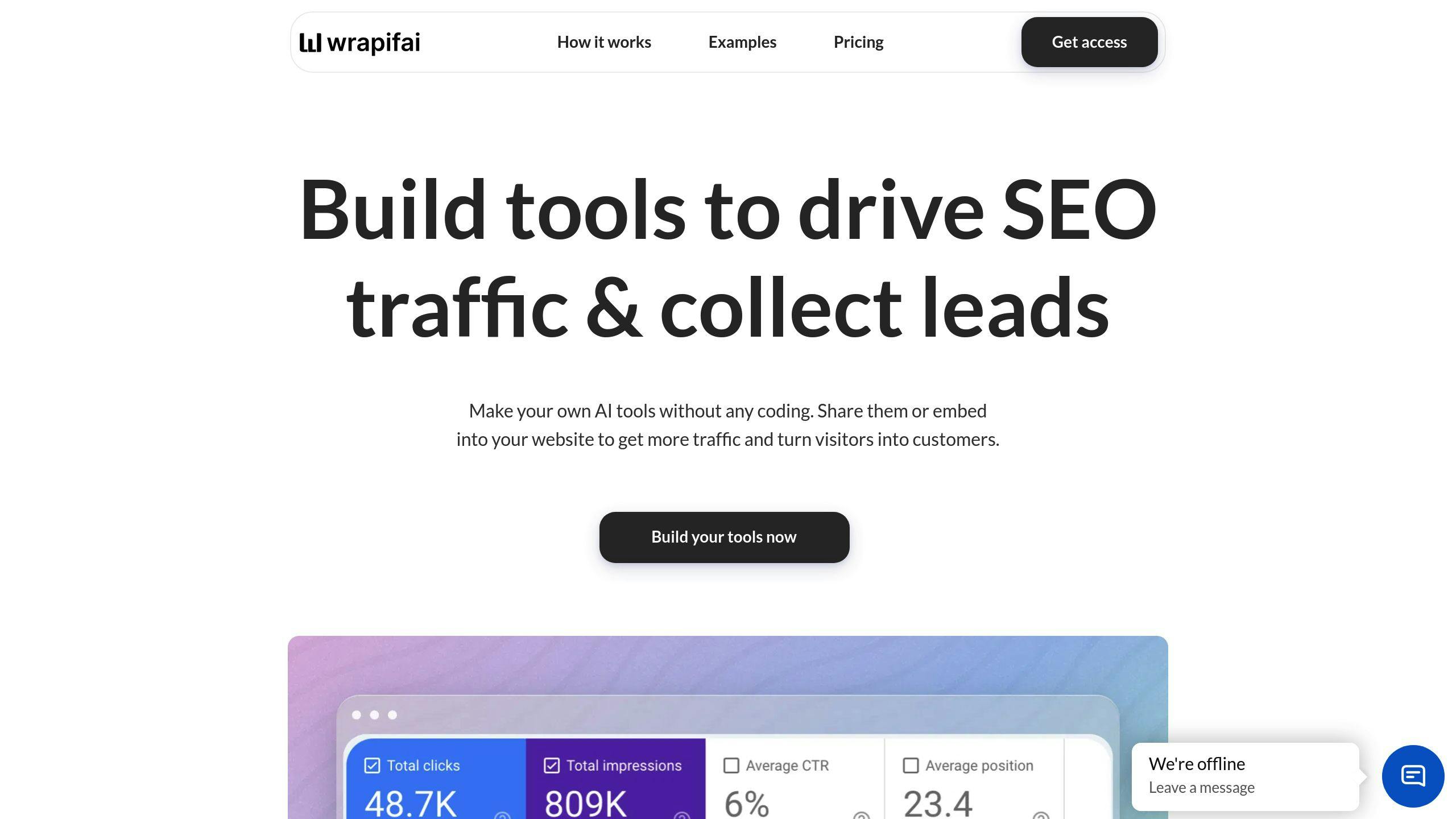Choosing between no-code AI platforms and traditional chatbots depends on your goals, budget, and technical resources. Here's a quick breakdown:
- No-Code AI Platforms: Ideal for fast deployment and low-cost solutions. No technical skills needed. Great for small businesses and simple customer support tasks.
- Traditional Chatbots: Best for advanced customization, complex workflows, and large-scale operations. Requires coding expertise and more time to build.
Key Differences
| Feature | No-Code AI | Traditional Chatbots |
|---|---|---|
| Ease of Use | No coding required | Programming skills needed |
| Development Time | Hours to days | Weeks to months |
| Customization | Limited | Extensive |
| Cost | Lower upfront | Higher upfront |
| Scalability | Platform-dependent | Highly scalable |
Quick Tip: Use no-code AI for simple, quick solutions. Opt for traditional chatbots if you need deep customization or compliance features.
Let’s dive deeper into the pros, cons, and use cases for each option.
Generative vs Rules-Based Chatbots
Differences Between No-Code AI and Chatbots
Understanding the key differences between no-code AI and traditional chatbots can help you decide which option suits your needs. Let’s break it down by usability, speed, and customization.
Ease of Use
No-code AI platforms are designed for non-technical users. With drag-and-drop tools and pre-built templates, they make it easy for teams like marketing or customer service to create and manage chatbots without needing coding skills [1][3].
On the other hand, traditional chatbots demand a higher level of technical expertise. Developers with programming skills are required to build, customize, and maintain these systems. This often results in longer implementation times and the need for specialized teams [1].
Deployment Speed
No-code AI platforms shine when it comes to deployment speed. Basic chatbots can be launched within hours, allowing businesses to quickly test and refine their solutions [1][4].
Traditional chatbots, however, follow a more structured development process. From gathering requirements to coding, testing, and deploying, the timeline can stretch significantly. While this approach ensures a solid end product, it’s not ideal for businesses that need fast results [1][2].
Flexibility
When it comes to flexibility, traditional chatbots take the lead. They allow for deeper customization, better control over features, and more complex integrations. This makes them suitable for businesses with unique or advanced requirements [1][3].
No-code AI platforms prioritize ease of use and quick deployment, which can limit customization. However, many platforms, like ApiX-Drive, are improving their integration and scalability options, making them a viable choice for less complex needs [1][2].
| Aspect | No-Code AI | Traditional Chatbots |
|---|---|---|
| Technical Expertise | No coding required | Requires programming skills |
| Development Time | Hours to days | Weeks to months |
| Customization | Limited to platform tools | Extensive and highly flexible |
| Integration Options | Pre-built connectors | Custom integrations possible |
| Maintenance | Managed by platform | Requires in-house developers |
These distinctions help outline the strengths and limitations of each option, making it easier to align them with your business goals.
Pros and Cons of No-Code AI and Chatbots
Strengths and Weaknesses of No-Code AI
No-code AI platforms are opening up AI capabilities to businesses across the board. Their biggest advantage? They’re budget-friendly and can be implemented quickly without requiring specialized technical skills [1][4].
Another plus is that these platforms handle maintenance and updates for you. This means your team can focus on achieving business goals instead of dealing with technical upkeep [1][3].
But they’re not without limitations. The most common issue? Limited customization. While they offer templates and pre-configured options, they often fall short when it comes to handling advanced workflows like multi-step decision-making or adhering to industry-specific compliance requirements [1][3].
Strengths and Weaknesses of Chatbots
On the other hand, traditional chatbots shine in situations that demand deep customization and complex integrations. They’re ideal for handling intricate business logic and give you full control over the development process - perfect for enterprises that need advanced features [1][3].
However, the trade-offs are considerable. They come with higher development costs and take longer to implement. Plus, they require ongoing maintenance from skilled developers, which can stretch the resources of smaller businesses [1][3].
Deciding between these options means understanding how their strengths and weaknesses align with your business goals. Below is a comparison table to help clarify the differences.
Comparison Table: No-Code AI vs Chatbots
| Factor | No-Code AI | Traditional Chatbots |
|---|---|---|
| Initial Cost | Lower upfront investment | Higher development costs |
| Maintenance | Managed by the platform | Requires a technical team |
| Time to Market | Hours to days | Weeks to months |
| Technical Skills | Minimal expertise needed | Advanced programming required |
| Customization | Limited to platform tools | Extensive customization |
| Integration Options | Pre-built connectors | Custom integrations |
| Scalability | Depends on the platform | Highly scalable |
| Performance | Best for standard use cases | Tailored to specific needs |
"No-code AI tools are evolving rapidly to cater to enterprise-level needs, offering a paradigm shift that allows businesses to drive chatbot development faster and more efficiently" [3].
The decision ultimately boils down to your business needs, resources, and future plans. If you’re looking for quick deployment and lower costs, no-code platforms might be the way to go. But for enterprises requiring flexibility and control, traditional chatbots remain the better option.
sbb-itb-c495ab1
Use Cases for No-Code AI and Chatbots
When to Use No-Code AI
No-code AI works best for businesses that need quick and low-effort chatbot solutions. These platforms are especially useful for:
- Handling routine questions and providing round-the-clock support.
- Qualifying leads through interactions on websites.
- Delivering multilingual support across various channels.
Unlike traditional solutions that can take months to build, no-code AI platforms can have chatbots up and running in just a few days [1][2].
When to Use Chatbots
Traditional chatbots are a better fit for businesses with more complex needs, such as handling secure processes or meeting strict compliance requirements. They are particularly effective for:
- Managing multi-step booking processes.
- Processing secure payments.
- Implementing custom security measures.
- Meeting industry-specific compliance standards.
- Performing advanced data analysis.
While traditional chatbots handle complex tasks, no-code platforms like Wrapifai show that simplicity and functionality can coexist.
Example: Wrapifai No-Code AI Platform

Wrapifai is a great example of how no-code platforms simplify chatbot creation. It provides businesses with tools to build branded, embeddable AI solutions without needing technical expertise. Features include performance tracking, SEO tools, and scalable deployment, making it a fit for both startups and large enterprises.
The platform offers flexible pricing to cater to different business needs:
| Usage Level | Best For | Key Capabilities |
|---|---|---|
| Basic | Small businesses & startups | Tool builder, basic customization, embedding |
| Professional | Growing companies | Custom branding, performance analytics, SEO tools |
| Enterprise | Large organizations | Unlimited tool creation, advanced analytics, full customization |
This tiered approach allows businesses to choose between simplicity and advanced features based on their specific goals and resources. No-code platforms like Wrapifai continue to close the gap between basic chatbots and more advanced AI, making sophisticated tools accessible to a wider range of businesses [1][3].
Conclusion
Deciding between no-code AI platforms and traditional chatbots comes down to your business's specific needs, available resources, and long-term goals. No-code AI platforms allow for quick deployment and reduced costs, making them a practical choice for businesses looking to implement chatbots without diving into complex technical setups.
On the other hand, traditional chatbots require more upfront investment and technical expertise but are better suited for companies with complex requirements. They shine in areas like deep customization, strict security needs, and meeting specific compliance standards.
Many businesses may find that starting with no-code AI is a great way to test the waters before transitioning to more advanced traditional chatbot solutions as their needs grow. While no-code AI emphasizes speed and cost-efficiency, traditional chatbots are better for tailored solutions and larger-scale operations.
When planning your chatbot strategy, consider these factors:
- How much time and resources you can dedicate to development
- The level of customization your business requires
- Security and compliance standards you must meet
- Scalability as your business grows
- Compatibility with your existing systems
Success depends on having clear objectives and a well-thought-out conversational AI plan. Instead of following trends, focus on what aligns best with your business goals and customer needs. The best chatbot solution is one that supports your unique objectives and delivers value to your users.
FAQs
How to differentiate between rule-based chatbot and AI chatbot?
In the world of chatbots, it's crucial to know how rule-based chatbots and AI-driven chatbots differ. Each type serves distinct purposes, depending on your business needs.
AI chatbots use artificial intelligence to learn and evolve through user interactions. They can:
- Understand and process natural language.
- Provide responses tailored to user context.
- Manage complex queries with more flexibility.
- Improve automatically as they interact with users.
Rule-based chatbots, on the other hand, operate on fixed rules and patterns. They:
- Follow strict, predefined instructions.
- Respond based on exact keyword matches.
- Lack the ability to learn or adapt.
- Perform best in simple, predictable scenarios.
| Aspect | Rule-Based Chatbot | AI Chatbot |
|---|---|---|
| Learning Capability | No learning ability | Continuously learns |
| Response Generation | Fixed, rule-based responses | Context-aware responses |
| Maintenance | Requires frequent updates | Improves on its own |
| Best Use Case | Simple, structured tasks | Complex, dynamic interactions |
| Implementation Cost | Lower upfront, higher upkeep | Higher upfront, lower upkeep |
For businesses, understanding these differences is key to selecting a chatbot that aligns with their needs - whether it's for straightforward tasks or handling more advanced, scalable interactions.


